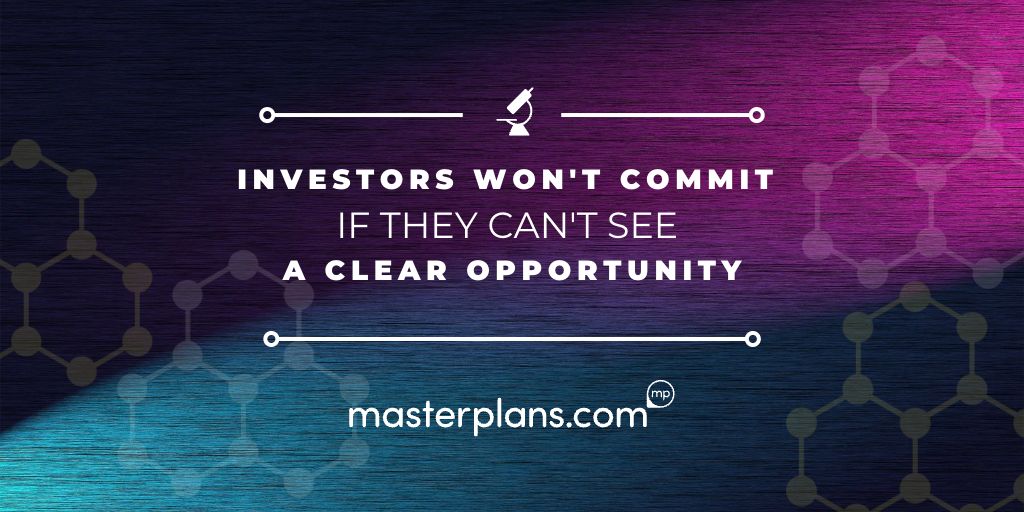How to Write a Management Summary for Your Business Plan
Entrepreneurs are often celebrated for their uncanny ability to understand others – their customers, the market, and the ever-evolving global...
7 min read
![]() Brent Butler
Oct 27, 2022 8:42:41 AM
Brent Butler
Oct 27, 2022 8:42:41 AM

I was on a Zoom with a client when he posed a tricky question:
“What’s the most important part of the investor presentation?”
I had to pause and think about it. Why had hundreds of other clients gotten a “yes” from investors?
Was it the time a client was certain that the investment would yield a 10x return over five years (a.k.a., the money slide), as most would have you believe? Was it the opening of the presentation, the problem statement? Was it the benefits the customers would receive from using the product?
Truth is, investor materials (elevator pitch, executive summary, pitch deck, etc.) is what Aristotle would call a “the whole is greater than the sum of the parts” scenario. But what is the “most important part”?
As I considered my answer, I kept thinking through the times when I saw prospective investors put away their phones, stop doodling on their legal pad, sit forward, and start listening. Then it dawned on me, that all too familiar quote attributed to Richard Branson:
“If somebody offers you an amazing opportunity but you are not sure you can do it, say yes.”
“Your opportunity analysis,” I blurted. And as much as others will bury the lede with statements like “investors only care about one thing: ROI” or “these are the only 3 things investors really care about.” it is an opportunity that they say yes to. The opportunity is the skeleton for the body of your presentation.
But how do you begin to speak about opportunities in a way that investors can grasp? A way that will get them to sit forward in their seat and pay attention? Well, turns out that’s what we’ve been doing well for decades and I’m happy to show you.
Before I go too much further, realize that objective opportunity analysis might just kill your startup concept. Why?
Opportunity analysis isn’t about confirmation bias, it’s about a near scientific observation to understanding the space you're in, which is why I use a microscope metaphor.
By using the opportunity microscope, and its set of lenses — 10x, 20x, 40x and so on — you, the scientist/entrepreneur, are going into the laboratory with a set of assumptions or a thesis, but you are using a tool (the microscope) to look deeper into how your subject (your idea, MVP, prototype or early-stage startup) appears through different lenses. And you’re going to be as honest and objective about your findings as you possibly can be.
The first level is the standard microscope and whatever magnification setting it comes with out of the box … this is your opportunity analysis.
Launching a new product or service, starting a new business, or increasing the product offerings of an existing business can all be evaluated with the use of an opportunity analysis. Demand, customer needs, market acceptance, and the economy are all understood through the method's examination of external factors.
Opportunity analysis can help to develop the best business model(s) to use in a given situation or hearken a change in a business model when the environment changes, which was the case for many businesses in 2020 when the pandemic hit.
“Within every adversity is the seed of an equal or greater opportunity.” — Napoleon Hill.
As an example, let’s look at Purple Innovation, Inc., makers of the Purple Mattress and other bedding products. Rather than lament the misfortune that disrupted its planned expansion in both wholesale capacity and retail showrooms, the company quickly realized an opportunity and pivoted its resources into the accelerating online shopping arena, resulting in direct consumer orders increasing 125% in April of 2020 when compared to the previous year.
The traditional questions to answer when conducting opportunity analysis are:
From this point forward, you want to begin using various opportunity analysis lenses to observe and note new information. Just like a microscope, you switch to the new lens and try to determine if there is anything new to observe. If not, switch to the next lens, and so on. At each subsequent magnification you are looking for new, observable data.
Pro Tip: If you are using this method objectively, you will most likely come across information that disagrees with your assumptions. It’s incredibly important that you deal with this information in your business plan or you use it to innovate or adjust your strategy.

Opportunities can be identified and leveraged by analyzing changes in the greater environment, factors such as government regulation or industry stimulus, new technologies, mass user migrations from one platform to another, and actual environmental changes such as increased droughts, forest fires, hurricanes, or human migration can create massive opportunities for innovative and aware companies.

In its simplest form, direct competition opportunity analysis is learning about the product or service offering of your competitors, researching the marketing and sales tactics and results, understanding their pricing and associated costs (i.e. shipping, extended warranty, etc.), their content strategy (or lack thereof), and their social media presence (or lack thereof). Once this information is understood, the analyst and the strategist can use this information to determine if there is sufficient room to innovate or create a competitive advantage in one or more of the aforementioned categories.
An indirect competitor is when a company targets the same customer need in the same market as your company but does so with a different product or service. This is usually described best with some well known examples: McDonalds and Burger King = Direct Competitors. Domino’s Pizza and Papa Johns = Direct Competitors. Domino’s Pizza and McDonalds = Indirect Competitors. All four sell a product to meet the same need (hunger), but their products are very different. By analyzing your indirect competitors, in much the same way you did your direct, you may uncover opportunities such as new business models that work in the market, creative ideas and new angles, a better understanding of the consumer, and more.

In some cases, the objective of a company is not to continue a business-model-as-usual within a particular industry segment but instead chooses to expand an innovative new model. In other industry opportunities analysis, you're analyzing the existing industry players and asking the question: What if I were to introduce a new product, service, SaaS, or model to create a wholly new opportunity? Other industries opportunities analysis is typically the arena of innovation and the entrepreneur is focusing on broad customer needs and delivering a novel solution.

Probably the easiest to understand, but often overlooked lens is analyzing products that are complementary to what you plan to sell. However, when conducting complementary products analysis the devil is in the details. Factors of products that are complementary to yours such as packaging, price, customer segmentation, usage rates, customization, and more will all factor in. In other words, you have to look at products that are complementary to yours with both an analytical and creative eye.

Oftentimes, we don’t get into the details of the when, where, and how of the purchase situation of customers, to our own detriment. The purchase situation analysis looks at the distribution channels, payment methods, and all other circumstances involved in the purchase decision to uncover opportunities to make it easier for customers to buy our products or services. Extremely innovative products and services, or even full business models, have been built around delighting customers by giving them what they want, when they want it, and with methods of payment that work for them.

Without a deep understanding of how a company’s best current or prospective customers are segmented, the organization generally lacks the focus needed to understand opportunities present and prioritize resources (human and capital) efficiently to leverage those opportunities. At its most basic, consumer segmentation is the division of potential customers in a given market into discrete groups. These groups are determined by asking these questions:
An example of how segmentation can help identify market opportunities for a startup is Hint, Inc., a bottled water company based in San Francisco, California. Several years ago the company’s founder, Kara Goldin, and I were discussing the planning of the company and fundraising efforts. Bottled water was perceived as healthy but did not offer the attribute of good taste. Soft drinks and juices taste good, but even juices were perceived as bad for you.
Kara saw an opportunity for healthy drinks that offered both taste and flavor, and she knew that health-conscious Silicon Valley tech employees who were used to refrigerators stocked with sugary or diet beverages would see the benefit. As a result, Hint was born and launched flavored bottled water of the same name with great success. According to the company, their sales have eclipsed $100 million.
HubSpot began as a software developer for inbound marketing, but has consistently moved upmarket by uncovering opportunities, even amongst its integrated partners, making them direct competitors, namely Salesforce. Salesforce, the clear market leader for CRMs, suffered by failing to deliver on the benefits it promised. As Andrew Shaw points out, this is primarily due to the fact that Salesforce was “built by acquisition, resulting in a clunky, cobbled-together solution.”
Through deep direct competition analysis, HubSpot became acutely aware of this problem as it analyzed what would be its direct competitor, and built a CRM from the ground-up to integrate with its marketing platform, allowing its enterprise users to support the entire customer journey.
We all know that Uber disrupted the taxi industry with digital innovation, virtually breaking a monopoly taxi companies had on cities and airports. Uber understood that people needed to get from point A to point B and that they were willing to pay for it, but one thing the taxi industry could never do was to operate from economies of scale across cities.
By offering a different product, the ability for virtually any driver to participate in the rideshare economy, Uber (and then its fast-follower Lyft) sent the traditional taxi companies’ market share tumbling. Uber fundamentally understood that having to find a local taxi company’s number or trying to hail a cab on a busy street in the rain was an outdated model and rethought the product offering.
Whew!
We covered a lot in this blog. And we did so because opportunity analysis is so critically important. In my experience, good opportunity analysis is the difference between a business plan and model that is met with a lukewarm reception and one that passes muster with aplomb and garners the confidence (and checkbook) of investors.
Take your time; using this method will invariably uncover new opportunities. And if your business concept doesn’t look so great after conducting this disciplined approach, fear not because you’ve saved yourself a great deal of time, money and heartache. And, and more importantly, you now have a set of tools that will serve you well in the future.

Entrepreneurs are often celebrated for their uncanny ability to understand others – their customers, the market, and the ever-evolving global...

Despite growth in sectors like artificial intelligence, venture capital funding has seen better days. After peaking at $347.5 billion in 2021, there...

Most people think of a professional business plan company primarily as a "business plan writer." However, here at Masterplans, we choose to approach...